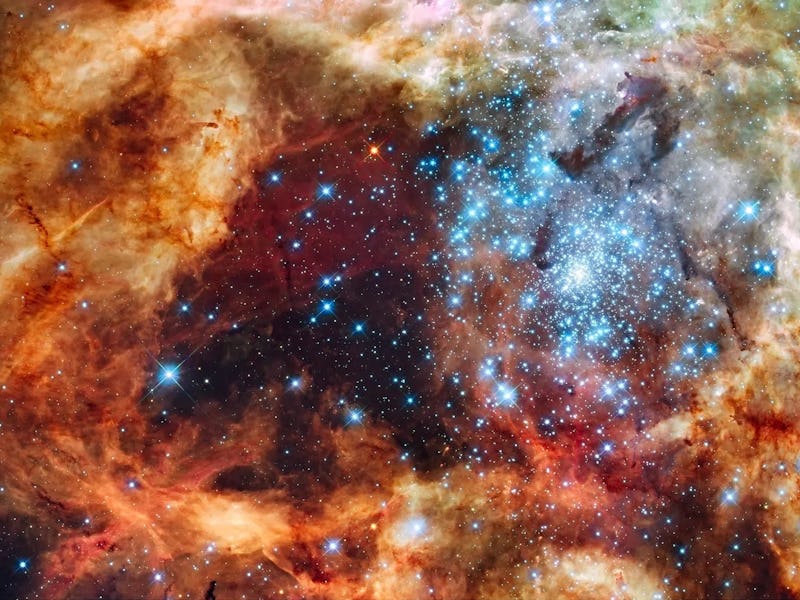Hubble Scrutinized Hundreds of Newborn Stars to Untangle How Galaxies Evolve
The survey focused on two dramatically different groups of stars.

Life in the universe could depend on the vicissitudes of two wildly different types of stars.
A team of astronomers recently used the venerable Hubble Space Telescope to study the light of 495 stars — some from dusty star-forming neighborhoods in our own galaxy and others from galaxies nearby. The survey, called Ultraviolet Legacy Library of Young Stars as Essential Standards (ULYSSES), took about three years and focused on two very different kinds of newborn stars: the very large and the very small. All that data could also hold some important answers about how the ingredients for life get scattered around young galaxies, and how young red stars might irradiate potentially habitable worlds.
This Hubble Space Telescope image shows a star-forming region containing massive, young, blue stars in 30 Doradus, the Tarantula Nebula, in the nearby Large Magellanic Cloud.
From the Largest Stars to the Smallest Ones
ULYSSES used Hubble’s ultraviolet instruments to measure the spectrum of light coming from two groups of newborn stars. One group is giant blue stars, many times more massive and thousands of times brighter than our Sun, destined to live fast and die young in a cataclysmic explosion. The other group are red dwarfs, just a fraction of our Sun’s mass, with a faint reddish glow and a slower, steadier lifestyle (except for their temperamental early years).
For the massive blue stars, the ULYSSES team looked in galaxies that don’t already have their own supply of elements heavier than helium. These galaxies, where nearly everything is made almost entirely of hydrogen and helium, look like some of the first galaxies in the early universe, before the first generation of stars scattered the first heavy elements across the cosmos.
Many of the ingredients for life — chemical elements like carbon and oxygen — come from the thermonuclear fusion at the heart of bright blue stars, 20 to 25 times more massive than our Sun. These burning giants blast the space around them with powerful stellar winds, laden with ultraviolet radiation and electrically-charged particles. And those stellar winds carry some of the heavy elements the stars produce in their cores, scattering those ingredients for life (and rocks, and everything else that’s not hydrogen or helium gas) around the galaxy.
At the other end of the stellar size spectrum, Hubble studied newborn red dwarfs: the small, dim stars that make up about 75 percent of the stars in our galaxy. On the power of sheer numbers, these little stars are where we’re most likely to find evidence of alien life, if it exists (their planets’ atmospheres are also easier to see).
Because they’re small and slow-burning, these little red stars are also some of the longest-lived in the universe, but their formative years are wild and destructive. Young red dwarfs sometimes erupt in sudden outbursts of ultraviolet and X-rays, irradiating anything nearby, including planets in what would otherwise be the habitable zone. ULYSSES used the spectrum of ultraviolet light coming from these stars to learn how their unstable blasts of radiation affect the newborn planets coalescing from gas and dust around them.
The ULYSSES team hopes their data can shed light on how newborn stars at both ends of the scale shape their host galaxies and the planets that eventually orbit them.